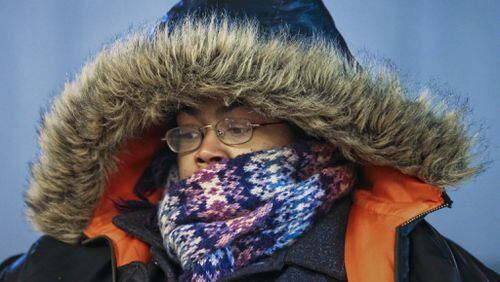If Tuesday’s 10-degree weather prediction holds true, metro Atlanta residents can expect a whole lot of cold feet, icy roads and, given human history, newborns in the next nine months.
A cold front on Monday is expected to usher in an arctic air mass that will cause temperatures to dip into the single digits, the coldest it’s been in a decade, said Ryan Willis, a meteorologist with the National Weather Service.
“We’re not totally sold on the snowfall just yet because we’re not sure the cold air will get here in time to change the rainfall to snow,” Willis said. “Still on Monday we’re only looking at highs, about 33 degrees, right around freezing.”
The coldest temperatures will be on Tuesday, when the morning low will be in the single digits, primarily in the northern suburbs, Willis said.
Willis suggested residents limit outdoor exposure because such low temperatures can cause hypothermia pretty quickly.
“But here in Georgia, it’s never really cold enough to hibernate,” said Emily Stoniecki, exercise physiologist at Children’s Healthcare of Atlanta. “Playing outside is a great way to amp up activity, rev germ fighters, even boost mood.”
Contrary to popular belief, Stoniecki said cold weather doesn’t make you sick. Illness is caused by viruses and bacteria, not falling temperatures. Spending time indoors, where germs spread more easily, is the likely culprit behind more winter illnesses.
Still as temperatures drop, drivers should take precautions to stay safe and warm. If you must get on the road, keep a warm blanket, flashlight and charged cellphone handy, said Natalie Dale, spokeswoman for the Georgia Department of Transportation.
Meanwhile, GDOT has been making and stockpiling a brine or liquid salt solution that it will be spreading across interstates and routes that it hopes will lower the chances of roads freezing over.
“Hopefully we will see less ice and fewer disruptions to the traveling public,” she said.
Dale said, however, that HERO units will be out patrolling interstates looking for stranded motorists and they also can be dispatched by calling 511. Motorists also can follow GDOT on Twitter (http://twitter.com/gadeptoftrans) and Facebook (http://www.facebook.com/GeorgiaDOT) for frequent updates and news on where the hot spots are for ice and snow.
Protecting you, your family
Here are some ways to winterize your family:
- Dress in layers. As you warm up, you can peel off.
- Keep the heat in. Cover hands, feet and head to keep heat from escaping.
- Drink up. You can get dehydrated in warm or cold weather, so keep the water coming.
Source: Strong4Life at Children’s Healthcare of Atlanta
Think ahead
Emergency supply list for your home:
- an alternate way to heat your home during a power failure
- furnace fuel
- electric space heater with automatic shut-off and non-glowing elements
- blankets
- multipurpose dry chemical fire extinguisher
- first-aid kit and instruction manual
- battery-powered radio, flashlight and clock
- nonelectric can opener
- rock salt and snow shovel
Survival kit for your car:
- blankets
- first-aid kit
- a can and waterproof matches to melt snow for water
- windshield scraper
- booster cables
- road maps
- compass
- tool kit
- paper towels
- bag of sand or cat litter
- tow rope
- collapsible shovel
- container of water and high-calorie canned or dried foods and a can opener
- flashlight and extra batteries
Source: Centers for Disease Control and Prevention
Staying on your feet
Tips to avoid falling on the ice:
- "Do the shuffle": If you must walk on ice, walking in a shuffle or moving your feet only slightly apart provides better balance than your normal stride. Bending your knees as you walk just slightly also will help.
- Walk sideways on inclines: Turn sideways and avoid the "normal" walking motion of crossing one foot over the other. It is safer to take a sidestep and bring your other foot along to meet your lead foot.
- Protect your dominant arm: Falls occur quickly, and it is common to use your arms to break your fall, leading to arm fractures and tears. To avoid injury to your dominant arm, hold an object or a bag in it, leaving the other arm to break your fall.
- Be aware: Be aware of your surroundings to avoid visible ice. Take care when exiting cars, buses and trains or when walking up and down outdoor stairs. Keep your eyes open for patches of ice.
Source: Department of Orthopaedics at the Icahn School of Medicine at Mount Sinai, New York City
About the Author







